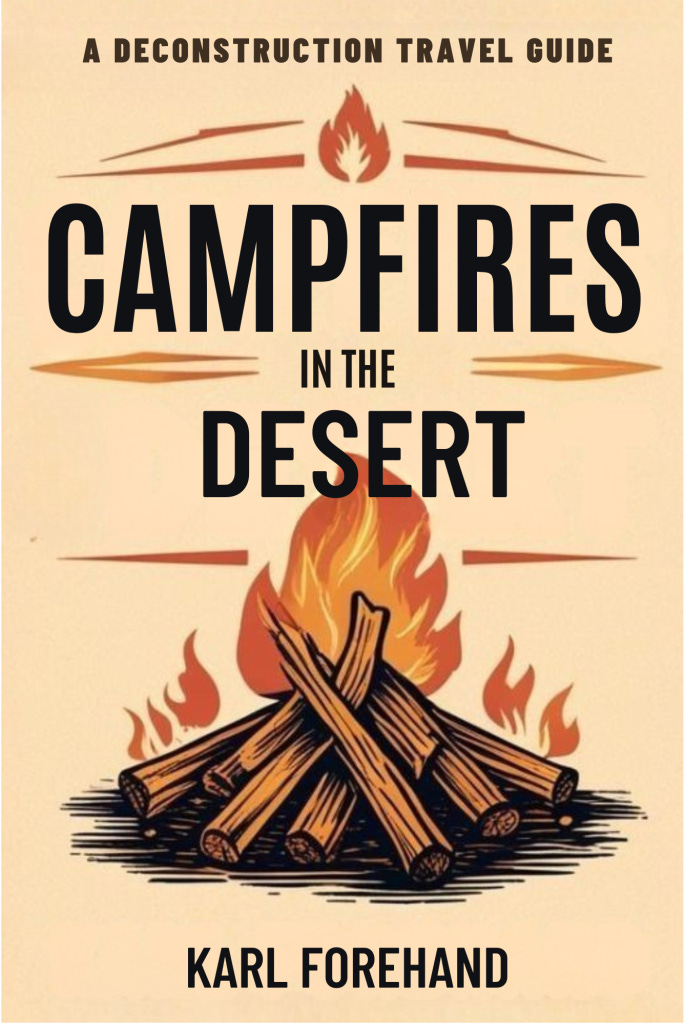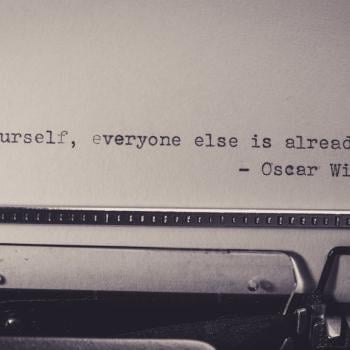A Course Correction for Deconstructing Evangelicals
“You are not lazy or unmotivated or stuck.
After years of living your life in survival mode, you feel exhausted.
There’s a difference.” – Nakia Homer
After leaving religion, I quickly realized that I had unresolved traumas I didn’t know how to face. For 20 years, we operated at full throttle, striving to do “God’s work” as if Jesus were returning tomorrow. We acknowledged our issues while also recognizing the efforts we needed to make. We had no solid theories about healing ourselves beyond the thoughts and prayers we hoped would eventually save us.
When we began to form new groups and establish a common language to support one another, we realized there wasn’t much of a path forward, and most travelers were wounded in various ways. Much like religion, we yearned for magical solutions, and as we explored new practices, we resisted the temptation to adopt them as our new faith.
As we ventured through our deserts, we uncovered new insights, learned valuable lessons, and freed ourselves from theological burdens. However, we also understood that we had been in survival mode for many years. Since religion never provided time for grief, it was easy to overlook the discomfort within and dismiss our inner selves, which were crying out for help.
Our situation was more serious than we imagined and felt overwhelming until we took one step, then another, toward genuine healing. I encourage you to make this a top priority as well. While I can’t promise you a magical solution, I assure you that you can manage it, and you are not alone.
What is Survival Mode?
When in survival mode, our body’s stress response system activates. This system is designed to help us handle immediate threats from our environment and its inhabitants. Prolonged activation can negatively impact both our physical and mental health.
Although we don’t encounter the same physical threats as our ancestors, our bodies still react to stress in similar ways. Work pressure, financial worries, and relationship issues trigger the same chemicals in our bodies, keeping us in a perpetual state of heightened alert, even when there’s no immediate danger. The stresses of modern society can activate our stress responses, and if we’re not careful, we may find ourselves overwhelmed by our concerns.
Throughout my church experience, I was often encouraged to keep pushing forward, ignoring the warning signs because “God has a purpose” and “God knows what you’re going through.” Along with the pressures of real life, my church life also involved financial worries, anxiety, and relationship challenges. We never had enough time for the things that truly mattered, like prioritizing our mental health and allowing ourselves time to heal. We viewed everyone and every group different from us as a threat to our organization.
Over the past twenty years, I’ve taken a few sabbaticals but always returned home early. I claimed it was because I missed my family, which was true; however, my Christian upbringing whispered, “You’re wasting time doing nothing; you need to get back to work!” It also reminded me, “Come apart, lest you come apart,” but the Doers of the Word sermon echoed louder in my mind, and people seemed happy with me when I worked hard and did things rather than contemplated them.
Being in survival mode can have physiological effects. When stressed, the body releases hormones like adrenaline and cortisol, which increase heart rate and blood pressure. Before our evolved brains can reason, they instinctively shift into fight, flight, or freeze mode, determining whether to confront, escape, or react to the perceived threat.[1]
In survival mode, we become hyper-aware of potential dangers, with blood redirected from essential functions like digestion as we stay alert. It’s crucial to speak out against injustices and harmful individuals, such as church abusers. However, when in survival mode, every negative comment on social media can trigger our stress response system, feeling as threatening as the presence of dangerous animals.
When we find ourselves in survival mode, we may also experience psychological effects. We have been conditioned to normalize this behavior in our workplaces and religious communities. A typical example is hypervigilance, which refers to being unusually sensitive to our surroundings and remaining “on guard” in every situation to prevent adverse outcomes. Although there may be valid reasons for someone’s hypervigilance, it rarely yields positive benefits and should be addressed by a trauma-informed therapist.[2]
Survival mechanisms are intended for rare occasions and genuinely dangerous situations. They are ineffective for navigating our lives, as they can lead to various psychological issues, including anxiety, fear, difficulty concentrating, and emotional reactivity. Have you ever been in an argument where even the words seemed to threaten your well-being?
Like anything else, there are times when real threats to your survival exist. However, being right or wrong is not the end of the world or a real threat unless your body’s response system amplifies its feelings.
There are many reasons why our brains react the way they do. Sometimes, these reactions arise from traumatic experiences such as accidents, abuse, and natural disasters. Each person has unique responses and experiences related to these potentially traumatic events. Our response systems are also influenced by chronic stress and workplace pressures. This is also true for religion, where we believe we aim for a higher purpose while doing God’s work. When we combine work, religion, and the everyday pressures of relationships, finances, and our aspirations for success, we may find ourselves operating in survival mode.
Getting Out of Survival Mode
One of the best things we can do is identify the stressors in our lives. These may include the organizations and people we value most who directly and indirectly influence us. In the next chapter, I will discuss the importance of distancing ourselves from sources of trauma as we heal. This doesn’t mean we have to eliminate everything that causes stress or tension in our lives. However, we must recognize that stress and survival modes should be reserved for emergencies only. We cannot continue to live this way and must be strategic about where we invest our energy.
Later in this book, we will explore various regulation techniques that help us manage and respond to emotions in a healthy and productive way. These include mindfulness, deep breathing exercises, and constructively expressing our feelings. Infants are not born with the ability to self-regulate their nervous systems and are, therefore, dependent on the co-regulation of responsible caregivers.
Finding empathetic companions on our journey of discovery and healing is essential. This could be a friend, as long as they don’t serve as an echo chamber that keeps us stuck. It could also be a family member, although families often don’t deconstruct their experiences in tandem. Therefore, it’s typically beneficial to seek a trauma-informed therapist who can guide you and help you explore methods like somatic therapies and other valuable tools. A few of these will be discussed later in this text.
Since religion often offers misleading information about the body and brain, it may be beneficial to begin collecting accurate data on how our brains work in conjunction with our bodies. My denomination promoted the belief that we couldn’t trust the signals from our bodies, viewing them as inherently evil and sinful.
Exploring the brain within my religious context felt risky because the insights I gained often conflicted with the established beliefs that were passed down to me.
The cognitive dissonance I experienced was quite troubling; however, it also inspired me to delve deeper into the science of the brain and body and their interactions.
Here’s a brief summary of the insights we are gaining that have proven extremely valuable for our understanding. During your next downtime, I encourage you to explore the various online brain models. You don’t need a degree in neuroscience to understand the essential functions of different brain parts, their roles in survival mode, and how to escape it.
The Parts of the Brain
Studying the brain can be overwhelming due to its numerous parts and components. It is one of the most complex systems in the universe. Analyzing each part can be confusing because of its intricate web of messages, impulses, tissues, and its ability to process emotions. The brain stores our memories, communicates with our nervous system and other body parts, and receives signals that trigger further actions.
I’ve found it helpful to focus on some online three-part models. These models often explain in simple terms how the three parts of the brain work and how that affects us daily, especially when dealing with survival mode. We don’t need to understand every single function of the brain; instead, connecting its essential functions to our daily emotional experiences proves beneficial.
The oldest part of our brain, known as the reptilian brain or brainstem, is the most primitive component responsible for survival instincts such as breathing, heart rate, and defense. It remains focused on survival when the fight, flight, or freeze response is activated and a threat is detected. This part of the brain reacts quickly and unconsciously, often called a gut reaction or instinct. No two brains are exactly alike; this region is more developed in some mammals than others. It activates before the reasoning part of our brains has a chance to respond.
The mammalian brain, particularly the limbic system, is linked to emotions, social behaviors, and memory. It comprises several key components, including the amygdala, hippocampus, and hypothalamus. The amygdala processes emotions and detects threats, which can elevate heart rate, blood pressure, and breathing rate. It regulates stress responses and helps integrate emotions into memories.[3]
The hippocampus converts short-term memories into long-term ones, deepening our understanding of how trauma is stored.[4] The hypothalamus regulates bodily functions and maintains homeostasis, which is the optimal state for the mind and body.[5]
The neocortex, sometimes called the thinking brain, is associated with advanced cognitive functions, including consciousness and emotional regulation. It represents the most recent evolution of the human brain, which may become somewhat inactive during stress and dysregulation.[6]
A person may be described as “flipping their lid” when the more primitive part of the brain reacts to a perceived threat in their environment. We might say to each other, “They are not in their right mind,” or “They are not thinking clearly,” because their body and mind are out of balance, and this part of the brain is not fully engaged.[7]
I encourage you to explore some straightforward models online and find one that resonates with you, helping you understand how the process works. It made me realize that a part of my brain reacted to a perceived threat, even when I later analyzed the situation and knew it was just something simple that wasn’t a threat at all.
I understood that part of my brain nearly automatically reacts to threats, a necessary function in real emergencies. When I could pause long enough for the rational part of my brain to engage, I was able to regulate myself and respond more appropriately.
You may wonder whether the body drives the mind or the mind drives the body. The answer is yes! The body influences the mind through physical sensations that shape our moods, physical activity that relieves our stress, and signals that alert the mind to perceived stimuli. The mind affects the body through emotions and thoughts that impact our well-being and how we function in our environments. Regulating techniques such as mindfulness and breathwork can help balance the mind and body, enabling them to work better together.
Healing Our Trauma
Integrating trauma is achievable through practices like shadow work, inner child work, and various somatic therapies. These approaches can help reduce our automatic reactions to perceived threats, allowing us to respond more thoughtfully to life’s events. After considerable effort, I reacted with greater thoughtfulness instead of merely responding to triggers.
I might be jumping ahead by sharing these insights now, but I want to let you know that healing is possible. Some techniques and therapies are effective, and we cannot improve the situation by ignoring the pain.
The mind-body connection is crucial to our healing process. During my time in organized religion, we often clung to the hope for miracles because we didn’t fully understand how our bodies and minds could heal themselves. We were also taught to distrust ourselves, which often caused us to overlook our feelings. We relied on our beliefs and frequently ignored what our bodies tried to express.
Healing from trauma requires us to slow down and learn to feel, paying attention to what our bodies communicate. By integrating our past trauma, we react less and respond more effectively. Taking time to pause helps us regulate ourselves better and prevents future issues from arising. We cannot ignore or postpone our healing indefinitely, as our wounds keep us in survival mode and perpetuate this endless cycle.
Intentions play a crucial role in mindfulness techniques; however, our logical thinking often shuts down when we perceive a threat. Other parts of the brain, such as the amygdala, respond more quickly than our reasoning centers, leading us to react instead of thoughtfully processing the situation.
We should also avoid intentions that inadvertently let us evade our trauma. As I tell my children, “Problems typically do not improve when ignored.” Our unresolved trauma will keep resurfacing until we learn to confront and integrate it for our benefit.
Part of survival mode involves feeling trapped because we aren’t consistently managing our nervous systems and have not done the challenging work of healing from our trauma. When this occurs, we move from chaos to chaos and meltdown to meltdown without improving our overall well-being.
After 20 years in ministry, my nervous system had endured considerable stress, and it was only a matter of time before I faced an experience I hoped to avoid ever encountering again.
I hope I didn’t scare you off with this important point before we move forward in our discussion. I’m not sure I would have listened to someone share these ideas years ago, but I also don’t want you to remain in crisis mode longer than necessary. The hard truth is that we can’t persist forever in survival mode. The harm it causes should be unacceptable to us as humans, considering our remarkable ability to heal ourselves.
Keep these thoughts in mind as you navigate what we call The Desert. There will be many moments of joy and newfound peace, but avoid repeating the mistakes of organized religion. While happiness and joy likely result from any change we pursue, forcing ourselves into that mindset without engaging in the healing work can be counterproductive.
For now, let’s concentrate on the aspects of ourselves that sustain our survival. While struggle can certainly strengthen us in various ways, our survival instincts can sometimes lead to trauma. We can’t overcome these challenges with positive thoughts alone. A positive attitude is helpful, and recognizing that some suffering is unavoidable can be advantageous. However, when this trauma becomes stored in our nervous system, there’s a significant chance we might encounter it again. It only benefits us if we connect with it and integrate it for our well-being. More on this later.
With focused determination, you can start to shift out of survival mode.
Be where you are, Be who you are, Be at peace!
Karl Forehand
Photo by Rafa Barros: https://www.pexels.com/photo/close-up-photo-of-person-behind-leaves-1692821/
Coming in May!

Our New Course!
Religious Trauma Resources
The Desert Sanctuary Podcast
Karl Forehand is a former pastor, podcaster, and award-winning author. His books include Out into the Desert, Leaning Forward, Apparent Faith: What Fatherhood Taught Me About the Father’s Heart, The Tea Shop, and Being: A Journey Toward Presence and Authenticity. He is the creator of The Desert Sanctuary podcast and community. He has been married to his wife Laura for 35 years and has one dog named Winston. His three children are grown and are beginning to multiply! You can read more about the author here.
[1] https://www.mayoclinic.org/healthy-lifestyle/stress-management/in-depth/stress/art-20046037
[2] https://www.ptsduk.org/hypervigilance-and-ptsd/
[3] https://my.clevelandclinic.org/health/body/24894-amygdala
[4] https://my.clevelandclinic.org/health/body/hippocampus
[5] https://www.medicalnewstoday.com/articles/312628
[6] https://www.sciencedirect.com/topics/psychology/neocortex














